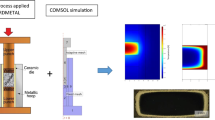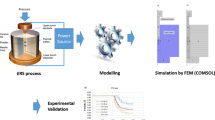Abstract
The paper reviews the efforts made to utilize powder metallurgy to solve problems encountered when using alloys at high temperatures. The following subjects are discussed: comparison of wrought and sintered super alloys, sintered aluminum powder, porous materials for transpiration cooling, molybdenum, and cermets.
Similar content being viewed by others
References
P. Schwarzkopf: Engineering Properties of Sintered vs Cast Materials. Product Engineering (1946) 17, No. 2, pp. 122–126.
G. J. Comstock and J. D. Shaw: Alloy Powder Products from Fully Alloyed Powders. The Physics of Powder Metallurgy (1951) Edited by W. E. Kingston. P. 372. New York. McGraw-Hill Book Co.
L. H. Mott: Progress Report on Hot Forging Pre-alloyed Metal Powders. Precision Metal Molding (1952) 10, No. 10, p. 38.
P. R. Toolin and N. L. Mochel: The High Temperature Fatigue Strengths of Several Gas Turbine Alloys. Proceedings ASTM (1947) 47, pp. 677–691.
J. P. Lyle, Jr.: Excellent Products of Aluminum Powder Metallurgy. Metals Progress (1952) 62, No. 6, p. 109.
E. Gregory and N. J. Grant: High Temperature Strength of Wrought Aluminum Powder Products. Trans. AIME (1954) 200, pp. 247–252; Journal of Metals (February 1954).
W. D. Jones: Progress in Powder Metallurgy. Journal Chemical, Metallurgical, & Mining Society, South Africa (1952) 52, pp. 216–222.
W. O. Schey: The Advantages of High Inlet Temperature for Gas Turbines and Effectiveness of Various Methods of Cooling the Blades. (1948) Paper presented at the Annual Meeting, ASME.
H. H. Ellerbrook, Jr. and L. J. Schaefer, Jr.: Application of Blade Cooling to Gas Turbines. NACA RM E50A04.
P. Duwez and H. L. Wheeler: Experimental Study of Cooling by Injection of a Fluid Through a Porous Material. Report, Jet Propulsion Laboratory. Journal of Aero Science (1948) 15, pp. 509–521.
G. J. Comstock, J. D. Shaw, C. L. Clark, W. V. Knopp, and G. M. Thomas: Minutes Meeting on Bureau of Aeronautics Sweat Cooling Project at Stevens Institute of Technology (February 24, 1949).
R. L. Probst: Investigation of Sintered Loose Spherical Powders for Fabrication into Transpiration Cooled Turbine Blades. Progress Reports Nos. 1, 2, and 3. Research and Development Div., Federal Mogul Corp., Detroit, Mich.
R. D. Grinthal, J. C. Bradbury, L. H. Mott, and G. J. Comstock: Investigation of Porous Material from Spherical Metal Powders. Bi-monthly Progress Report No. 5 Navy Contract Noa(s)-51-185-c (1951) Stevens Institute of Technology.
G. M. Thomas and G. J. Comstock: Process for Fabrication of Materials for Porous Turbine Blades. Progress Reports Nos. 18 and 19. Summary of 19 Progress Reports (June 1947 to April 1950), Progress Report No. 20. Powder Metallurgy Laboratory, Stevens Institute of Technology (1950).
G. M. Thomas, C. L. Clark, W. V. Knopp, J. D. Shaw, and G. J. Comstock: Process for Fabrication of Materials for Porous Turbine Blades. Progress Report No. 14 Powder Metallurgy Laboratory, Stevens Institute of Technology (Nov. 10, 1948).
M. Hill, O. W. Reen, D. H. Vermelyea, and F. V. Lenel: Production of Porous Metal Compacts. Bimonthly Progress Report No. 3 Navy Research Contract NOa(s) 11022 (October 1950) Rensselaer Polytechnic Institute.
G. M. Thomas, C. L. Clark, W. V. Knopp, J. D. Shaw, G. J. Comstock, and K. B. Davis: Process for Fabrication of Materials for Porous Turbine Blades. Progress Report No. 17 Powder Metallurgy Laboratory, Stevens Institute of Technology (June 30, 1949).
E. G. Pekarek: Operation of Thompson Molybdenum Plant. Final Report to Headquarters of Air Material Command Contract W-33-038-ac-20672 (January 28, 1952).
M. Semchyshen and H. E. Hastette: Arc-Cast Molybdenum Base Alloys. Third Annual Report (1952) Office of Naval Research Contract N8onr-78700, Task Order N8onr-78701, Project NR 034-401.
J. J. Harwood: Molybdenum, Our Most Promising Refractory Metal. Product Engineering (1952) 23, pp. 121–132.
J. J. Gangler: Some Physical Properties of Eight Refractory Oxides and Carbides. Journal American Ceramic Society (1950) 33, No. 12, pp. 367–374.
J. T. Norton: Some Observations on the Role of the Binder in Cemented Refractory Alloys. Powder Metallurgy Bulletin (1951) No. 6, pp. 75–78.
J. C. Redmond and E. N. Smith: Cemented Titanium Carbide. Trans. AIME (1949) 185, p. 987; Journal of Metals (November 1949).
E. M. Trent, A. Carter, and J. Bateman: High Temperature Alloys Based on Titanium Carbide. Metallurgia (1950) 42, p. 111.
P. Schwarzkopf and R. Kieffer: Refractory Hard Metals. (1953) pp. 396–397. New York. MacMillan Co.
D. G. Moore, S. G. Benner, and W. N. Harrison: Studies of High Temperature Protection of a Titanium-Carbide Ceramel by Chromium-Type Ceramic-Metal Coatings. NACA TN 2386 (1951).
A. R. Blackburn and T. S. Shevlin: Fundamental Study and Equipment for Sintering and Testing of Cermet Bodies. V-Fabrication, Testing, and Properties of 30 Chromium-70 Alumina Cermets. Journal American Ceramic Society (1951) 34, No. 11, pp. 327–331.
P. Schwarzkopf and R. Kieffer: Refractory Hard Metals. (1953) New York. MacMillan Co.
W. Arbiter: New High Temperature Intermetallic Materials. WADC Technical Report 53–190 American Electro Metallurgical Corp., Yonkers, N. Y.
W. A. Maxwell: Oxidation-Resistance Mechanism and Other Properties of Molybdenum Disilicide. NACA RM E52A04 (1952).
W. A. Maxwell: Properties of Certain Intermetallics as Related to Elevated-Temperature Applications. I-Molybdenum Disilicide. NACA RM E9G01 (1949).
W. A. Maxwell and R. W. Smith: Thermal Shock Resistance and High Temperature Strength of a Molybdenum Disilicide-Aluminum Oxide Ceramic. NACA RM E53F26 (1953).
W. G. Lidman and H. J. Hamjian: Kinetics of Sintering Chromium Carbide. NACA TN 2491 (1951).
H. J. Hamjian and W. G. Lidman: Influence of Structure on Properties of Sintered Chromium Carbide. NACA TN 2731 (1952).
C. A. Hoffman, G. M. Ault, and J. J. Gangler: Initial Investigation of Carbide-Type Ceramel of 80 Pct Titanium Carbide Plus 20 Pct Cobalt for Use as a Gas-Turbine-Blade Material. NACA TN 1836 (1949).
C. A. Hoffman and A. L. Cooper: Investigation of Titanium Carbide Base Ceramels Containing Either Nickel or Cobalt for Use as Gas-Turbine Blades. NACA RM E52H05 (1952).
E. M. Wise and R. H. Schaefer: The Properties of Pure Nickel-I. Metals and Alloys (1942) 16, pp. 424–428.
Metals Handbook (1948) p. 1183. Cleveland. ASM.
W. L. Havekotte: Super Refractories for Use in Jet Engines. Metals Progress ASM (1953) 64, No. 6, pp. 67–70.
J. W. Graham: Sintered Titanium Carbides Open New Industrial Horizons. Iron Age (1953) 172, pp. 148–152.
B. Maxwell and L. F. Rahm: Impact Testing of Plastics: Elimination of the Toss Factor. Bulletin ASTM (October 1949).
B. Pinkel, G. C. Deutsch, and N. Katz: The NACA Drop Test for the Evaluation of the Impact Strength of Cermets. NACA RM E54D13 (1954).
Author information
Authors and Affiliations
Additional information
Discussion on this paper, TP 3844E, may be sent, 2 copies, to AIME by Jan. 1, 1955. Manuscript, May 6, 1954. New York Meeting, February 1954.
Rights and permissions
About this article
Cite this article
Ault, G.M., Deutsch, G.C. Applicability of powder metallurgy to problems of high temperature materials. JOM 6, 1214–1230 (1954). https://doi.org/10.1007/BF03398361
Published:
Issue Date:
DOI: https://doi.org/10.1007/BF03398361




